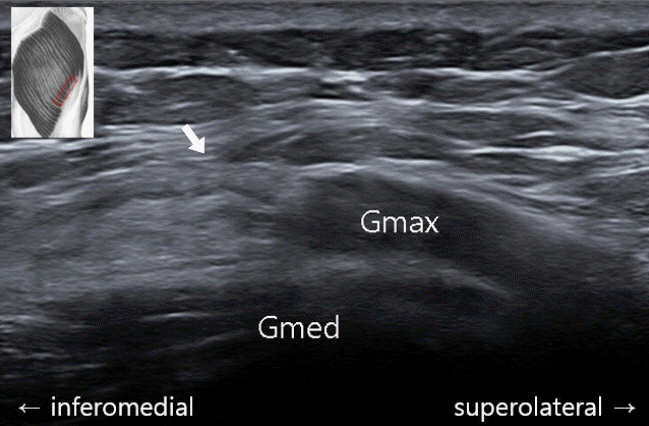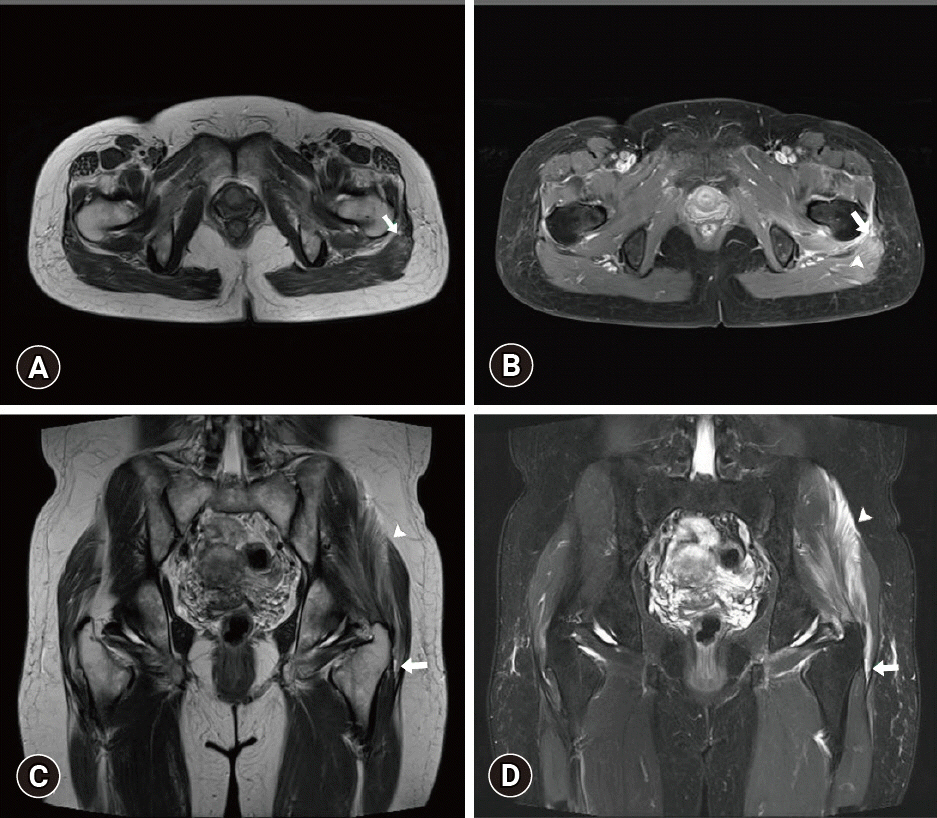Yeungnam Univ J Med.
2021 Apr;38(2):157-159. 10.12701/yujm.2020.00500.
Ultrasonographic and magnetic resonance images of a gluteus maximus tear
- Affiliations
-
- 1Department of Physical Medicine and Rehabilitation, Yeungnam University Hospital, Daegu, Korea
- 2Department of Radiology, Topspine Hospital, Daegu, Korea
- 3Department of Physical Medicine and Rehabilitation, Yeungnam University College of Medicine, Daegu, Korea
- KMID: 2515191
- DOI: http://doi.org/10.12701/yujm.2020.00500
Abstract
- The diagnosis of a gluteal muscle tear or strain is based on clinical findings. However, for an accurate diagnosis, imaging examinations are also needed. Herein, we describe the case of a patient with a gluteus maximus muscle tear confirmed by ultrasonography (US) and magnetic resonance imaging (MRI). A 58-year-old woman complained of dull pain in the left lateral gluteal region that she had been experiencing for 8 days. In the axial US image, retraction of the left gluteus maximus muscle was noted around its insertion site in the iliotibial band. On an MRI, a partial tear in the left gluteus maximus was observed at its insertion site in the left iliotibial band. In addition, fluid infiltration due to edema and hemorrhage was observed. A partial left gluteal muscle tear was diagnosed. The patient was treated with physical therapy at the involved region and oral analgesics. She reported relief from the pain after 1 month of treatment. Based on this experience, we recommend US or MRI for accurate diagnosis of muscle tear or strain.
Figure
Reference
-
References
1. Draghi F, Zacchino M, Canepari M, Nucci P, Alessandrino F. Muscle injuries: ultrasound evaluation in the acute phase. J Ultrasound. 2013; 16:209–14.
Article2. Noonan TJ, Garrett WE Jr. Muscle strain injury: diagnosis and treatment. J Am Acad Orthop Surg. 1999; 7:262–9.
Article3. Guermazi A, Roemer FW, Robinson P, Tol JL, Regatte RR, Crema MD. Imaging of muscle injuries in sports medicine: sports imaging series. Radiology. 2017; 282:646–63.
Article4. Selkowitz DM, Beneck GJ, Powers CM. Comparison of electromyographic activity of the superior and inferior portions of the gluteus maximus muscle during common therapeutic exercises. J Orthop Sports Phys Ther. 2016; 46:794–9.
Article
- Full Text Links
- Actions
-
Cited
- CITED
-
- Close
- Share
- Similar articles
-
- Extension Contracture of Both Hip Joints Secondary to Congenital Fibrous Bands of Both Gluteus Maximus Muscles: Case Report
- Gluteus Maximus Fibrosis: Report of 3 Cases
- Intramuscular Schwannoma Arising from the Gluteus Maximus Muscle: A Case Report
- Muscular Injury of Iliacus and Gluteus Maximus after Mountain Climbing
- Gluteus Maximus Fasciocutaneous V-Y Advancement Flap for Coverage of Sacral Pressure Sore



